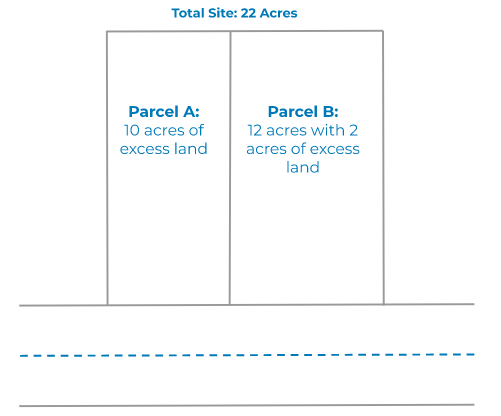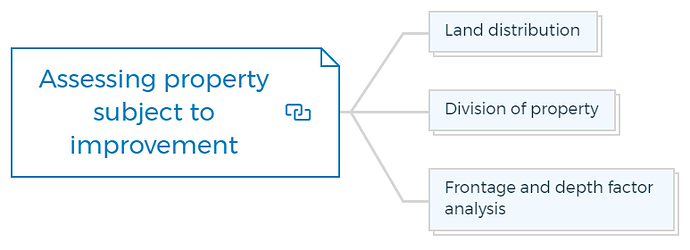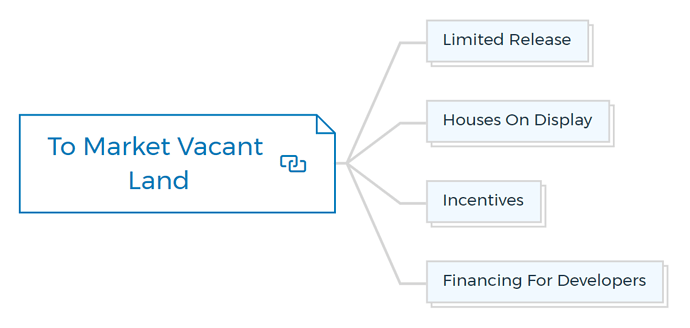Continued from…
Raw Land Development – What you need to know? [Part 1]
2. Make the highest and best use of vacant land
For a developed site, we consider the highest and best use (HBU) as if it were vacant, accounting for the expense of tearing down any existing improvements and getting the property ready for reuse.
The HBU needs a reverse determination—what is the value as if developed—for a land that is already vacant. Any ethically correct, physically practical, and economically viable usage could qualify as HBU.
An existing developed site frequently has a bias in favor of continuing to use “as is.” The HBU is a blank canvas with only a range of possible applications as restrictions while the site is unoccupied.
Consider a location with commercial zoning that could be transformed into one of the following four structures: offices, apartments, standalone restaurants, or light retail. The table below reflects raw land development.
Alternative HBU Calculations
It’s interesting to note that the project’s overall worth is not more than the value assigned to the location. Building an office complex will cost $10,100,000 to develop but will only generate a profit of $1,100,000.
In contrast, building light retail will cost less to complete but will provide an enormous profit of $1,600,000. Therefore, in this case, HBU calls for light retail growth.
Mixed-use land developments are becoming more and more prevalent today. For starters, zoning and land use regulations may stipulate that mixed-use be permitted in densely populated urban areas.
On the other hand, mixed-use can increase rents and create synergies between different land uses, even in suburban or less densely populated areas. The HBU for a vacant site may therefore involve optimising several applications rather than being a straightforward solution.
Usually, this is a two-step procedure. The most significant amount of space the market will accept will be considered first, typically in terms of square footage. Additionally, we will consider the smallest square footage that can be built and maintained.
Building a complex with 50 or even 100 apartments might be possible. However, running a 10-unit apartment complex could not be profitable or marketable to investors.
Second, think about the expenses and earnings per square foot. Standard features, such as green space, meeting spaces, community use spaces, or other recreational spaces that may be required by ordinance or enhance the overall site’s marketability, will also need to be considered.
You are missing out if you haven’t yet subscribed to our YouTube channel.
3. Find land size by comparing various elements
How do we calculate the size of the vacant land? Acreage? Based on square footage? Or something altogether different?
First, it is essential to be aware of surplus and excess land.
Any area of the property not currently required to support the existing improvement and does not have a separate highest and best use is considered surplus land. Surplus land may have no intrinsic worth.
A factory might need a 10-acre site to construct the building, supply parking for employees, and construct ramps for vehicles and exterior fixtures. The additional 2 acres offer little value if the location is 12 acres. Because there are two additional acres, no buyer of this factory will pay more.
Surplus and excess land

On the other hand, surplus land could have a unique highest and best use and value.
Use the same scenario, but suppose the site is 22 acres instead of 12. The additional 10 acres have contributed value because they might be individually sold off as a location for a different factory of a comparable type.
Learn More
Consider a plot of land in a typical, unexceptional, mainstream neighborhood. The lots in the development were initially meant to be roughly the same size and sell for roughly the same price or something similar.
Creating cookie-cutter lots will typically be defeated by considerations like topography, street design, preservation of trees and other vegetation, local land use regulations, and the desire to create an attractive neighborhood. Some lots will indeed end up being significantly more prominent than others.
Some lots may be much larger and more private, particularly at the ends of cul-de-sacs. The average lot in a relatively affluent suburban neighborhood may be 8,000 square feet in gross area, but a few may be closer to 10,000 or even 12,000 feet.
In the report’s assumptions and limiting circumstances, appraisers admit that they lack surveying expertise and often rely on land measurements from surveys or publicly available data.
As a result, the degree of precision and the units of measurement directly relate to the calibre of the underlying data sources. If the survey or tax assessment map showed square footage, the appraisal report also shows square footage.
To ascertain whether the value estimations are accurate and sufficient and whether the development or rental value is sustainable, readers of appraisal reports must carefully examine the quality and sufficiency of the site description.
4. Conduct feasibility test
If the potential earnings from an investment property can cover a reasonable rate of return on its entire cost (including indirect expenditures), that is, if the expected value upon completion is equal to or greater than the estimated cost, then the property is economically feasible.
Economic feasibility is established for any other non-real estate investment if the venture turns a profit. The weighted average cost of capital (WACC), which incorporates a return on equity investment, is one implicit cost for a project.
The “fair return” is typically broken out as a separate line item in real estate analysis. This is due to the possibility that various alternative site uses may have various needed rates of return.
Always combine sensitivity analysis with the feasibility analysis for every specific planned site use. To figure out different valuations, key variables should be changed for various possible outcomes.
To make an accurate Monte Carlo simulation, you can give these possible outcomes probabilities. Lenders are looking for these kinds of simulations more and more, and they often call them “stress tests.”
Several essential parts of a feasibility analysis need to be looked at carefully. These things are:
- Do some market research.
- Find the best combination of tenants or the best set of uses for a mixed-use proposal.
- Determine assumptions in detail.
- Find the acceptable range of those assumptions.
- Ensure simplicity.
- Separate the variables under the investor’s control from those that are not.
Learn More
An excellent feasibility study will rank the options for the investor and calculate the value differential between the best option and the other options.
The investor has a tool that may be used and reviewed during the project management phase if the feasibility study outlines the impact of control factors separately from external variables.
These should be included in an appraisal, but they lack depth and complexity too frequently. Know your number with instant access to the Property Development Feasibility Suite.
5. Net ground leases
A net ground lease enables a renter to develop a plot for a time. The improvements and the land revert to the landlord after the lease is over, subject to any option or renewal conditions.
Taxes, insurance, and maintenance fees are the tenant’s responsibility for the lease term, while the landlord will likely maintain general liability insurance and incur monitoring, legal, and accounting costs.
Most leases have terms of 20 years or longer, while net ground leases with terms of less than 10 years are uncommon. Major chain store tenants often have ground leases.
In contrast to standard triple net leases, net ground leases place no responsibility for the building on the landlord. The renter is often in charge of maintenance, which may be specified in the lease.
In a net ground lease, the tenant constructs the building (sometimes with landlord approval) and is in charge of all costs throughout the lease term.
There are typically two types of ground leases: subordinated and unsubordinated. To allow the tenant to finance the development, the ground owner consents to give construction or permanent lenders a lower priority in the first case.
The landlord essentially takes on the role of a junior lender for the project. The penalty of this subordination is typically a higher rent and additional concessions from the landlord.
In an unsubordinated lease, lenders will often still lend to tenants with good credit; they’ll just consider the lease when figuring out how much they can lend.
Learn More
Theoretically, there is no distinction between the value of a net ground lease and any other contractual cash flow with a remaining interest at the end of the term. Of course, the difficulty with land leases is that the residual value is a topic of considerable speculation.
Many ground leases are simply valued as raw land without considering the lease. For the investors, the ground lease or leases becomes more critical. While underlying quantification (matched pairs, trend lines), specific changes are significant and loaded with assumptions.
The starting point for any negotiations will always be the reconciled value from such an appraisal, even though the actual investment value can be quite different.
6. Assessing property subject to improvement
You wish to purchase a plot of land for renovation or investment, but there is already a structure there. There is a considerable difference between the seller’s perception of the property’s "value in use" or “investment worth” and your assumption that the HBU is for demolition and reconstruction.
You employ a valuer to estimate the tract’s value “as if vacant.” This is simple if there are sufficient neighbouring unoccupied land sites. The appraiser will turn to a land extraction if there are no comparable local properties or if they are insufficient to support the valuation.
We value the entire property and then deduct everything that is not the vacant land to create a cost method that works backwards.
Finding sales or rent comps can be challenging, given HBU’s controversy. The reader may erroneously concentrate on the land value without paying enough attention to the underlying assumption when interpreting and using the appraisal.
A building for an HBU move can have suffered much depreciation. Depreciation may, in fact, equal or come close to equaling the replacement cost. The “completely depreciated” structure may nevertheless receive rents or other benefits, which is a paradox to be aware of.
The rentals are frequently insufficient to support a “value in use” yet sufficient in many circumstances. In appraisals, you may identify more techniques with varying degrees of accuracy. These consist of:
Land distribution
Tax assessments are used as leverage in this. The tax assessor divides the fair market value (FMV) between the land and the improvements in the majority of jurisdictions.
The allocation ratio may be fair even if the total FMV is off. Therefore, comparing the allocations of similar properties to the sales prices of nearby homes with comparable sites may provide insight into the site’s worth.
Division of property
The evaluation may look at the expense of developing unimproved tracts into improved tracts and raw land. It is beneficial when there are many neighboring sales of raw land but few sales of improved sites.
Frontage and depth factor analysis
Site depth may be a deciding issue, especially in some metropolitan areas, as long as the site width is sufficient to comply with HBU’s “physically practicable” and “legally permitted” standards.
Frontage may play a decisive role in high-amenity settings (such as beachfront property). When there is some dissociation between value and site size, both methods may help find values.
How To Finance Your Property Development Project?
And Other Books On Real Estate Development Finance
Includes 5 x detailed eBooks
✓ Property Development Finance: Easily Finance Your Project? (26 Pages)
✓ 10 Big (Financial) Property Investing Mistakes Made By Investors (58 Pages)
✓ 10 Finance Options For Your Next Property Development Project (29 Pages)
✓ What Is Equity Finance And How Does It Work? (42 Pages)
✓ Property Investment Finance - Ultimate Guide
7. Perform subdivision analysis
Many parcels are bought to develop or divide them. Although land can be divided for residential and commercial uses, when the phrase “subdivision” is used, it typically connotes a residential community.
Industrial parks and out-parcels from shopping centres are two popular non-residential subdivision investments.
The sales comparison approach is typically highlighted when the appraisal is being used for loan purposes.
Four stages are used to value the land:
- Undeveloped property in need of development (the “as-is” condition)
- The developed lots as if sold at wholesale (such as a builder purchasing bulk lots)
- Land with the entitlements, permits, and all legal prerequisites to begin construction.
- The worth of completed lots after deducting the cost of marketing (a DCF model)
The land development analysis is separated from any subsequent site uses, even when a developer doubles as the end user, like a homebuilder or a retail centre developer. As a result, the land development ROI, feasibility, and valuation must be self-sufficient.
Reviewing the process of developing the undeveloped property into a subdivision of homes or businesses may be helpful. Almost always, this takes several years to complete.
Subdivision developments are “phased in” over several years since land development takes time. A developer may decide to construct 1,000 homes on a plot measuring 250 acres if the market can support 200 new residences annually.
Some infrastructure will need to be erected initially, but much of this may wait. Finalized plans frequently change over time. The market need could change, causing the next phase to switch to bigger or smaller lots or possibly another purpose (such as condominiums rather than single-family homes.
It gives the developer considerable flexibility and eliminates the requirement for an upfront financial commitment. The analysis will include discounted cash flows, just like any project with erratic cash flows.
From month to month, cash inflows and outflows will vary greatly, and the risks associated with each could be highly different. As a result, several discount rates might be used.
Finally, launching a project of this scale is unusual without sophisticated funding. Even in the planning stages, the capital structure must be integrated with the valuation research.
8. Solve unique problems in condemnation
There are disagreements among appraisers regarding enterprise value versus real estate value in large shopping complexes because they are collections of contractual connections.
There are many distinct schools of thought regarding this appraisal issue, especially in hotels, and various allocations may cause the appraisal to be located in various areas.
The figure below illustrates how two distinct appraisal procedures may produce the same overall value but use a different methodology to assign value to specific sub-components.
Different approaches to allocating value

An investor may favour one allocation above another for tax-related reasons. Recall that real estate (land and structures) usually is compensable in condemnation proceedings, but business values (everything else) are not.
A similar issue frequently affects hotels. The site value of a hotel can be significantly impacted by the loss of parking, especially if the property is a convention hotel and depends on parking.
Some approaches could classify the loss as non-compensable commercial site value, while others might see it as having an outsized impact on the entire hotel real estate site value.
Investment-grade real estate is frequently the target of inverse (regulatory) condemnation actions and physical condemnations. Investors, especially their attorneys, frequently make poor decisions when taking these steps.
Finance for land development
The feasibility analysis, but more crucially, the project’s cash flow following the anticipated stages or phases, will determine whether or not finance is approved for a subdivision land development.
Early in the development process, one should approach financial institutions to understand the project as the concept develops.
Before approaching a lender, make sure you have the following information on hand:
- A historical overview of the land and its environs
- A summary of the project as well as any distinguishing features
- A report on the property’s value
- The specifics of the market research
- Information on the development firm and its shareholders
- Information on the borrower’s financial situation
Learn More
What is the process for vacant land development approval?
Land subdivision permission differs from building development approval in that it involves many state and municipal governments, environmental organisations, and utility companies.
Each state has its development approvals process, in which you can take help from a local town planner or state planning department. You can understand the development process in detail with my article of 18 crucial steps for the development approval process.
However, keep in mind that each method will be different depending on the local government authority in charge of the area.
How to prepare raw land for construction?
The procedure for clearing the subdivision should begin once tender processes have been followed and a civil contractor has been hired to carry out the building work.
The appointed civil engineer should schedule inspections with various authorities to ensure that all necessary services have been installed correctly, such as earthworks, roads, and stormwater drains. All construction work must adhere to the approved blueprints and any additional conditions imposed by the relevant authorities.
As soon as the job is finished, submit ‘as constructed’ drawings for the issue of certificates of title. Remember that the contractor’s obligations end after a 12-month maintenance period. The contract should retain 2.5 percent of the contract sum, which will be released at the end of the maintenance period.
How to do marketing for vacant land?
You may choose to undertake ‘in-house’ marketing or hire professional advisors such as real estate agents, depending on the size of the development and the allocated money.
Through various media types such as newspapers, radio, pamphlets, and so on, the marketing exercise would create a particular community lifestyle. The start of the marketing campaign will be determined by a strategy developed based on the previous study.
The following factors drive a marketing programme:
- Whether pre-sales are a requirement for funding the project’s start-up.
- The current market situation and competitiveness
- Marketing research indicates that customers want to view the finished product before committing.
Learn More
Aside from those above, there are other marketing strategies that successful developers are using.
Limited release
The development will be released in stages if the limited release method is used. Each step has a finite number of lots, and there are always more purchasers than available lots, creating a “must buy” mentality before the price rises at the following step. Market conditions will determine the effectiveness of this strategy.
Houses on display
Most new land developments will have a few lots accessible for project builders at the entrance. This serves a dual purpose: it gives the project a more regular appearance.
Most project builders spend a significant amount of money on their promotion, luring vast groups of potential purchasers to the property.
Incentives
Various incentives can be used to entice purchasers, such as free fence or landscaping or a monetary discount on the early completion of the new home.
Financing for developers
Having the developer’s financier provide financing to potential buyers would benefit the developer, the buyer, and the financier. They will have already appraised the land and may offer better terms and conditions to buyers.
Rezoning
Rezoning a property from its current use to more commercially valuable zoning can bring substantial financial rewards to astute developers with vision and drive. This can be accomplished, for example, by purchasing a vacant piece of residential land and rezoning it to a shopping district.
The new zoning would have attracted a higher market value if the ground had remained residential. However, as described above, this is easier said than done because the developer will face several challenges.
Restrictions
Governments can regulate and control the specific use of land by restricting zoning. These zonings are in the public interest because they promote public health, safety, and welfare.
Zoning regulations should not be arbitrary, unfair, or discriminatory, and they should be clear, detailed, and simple to understand.
Possession of a rezoning permit
Local governments must consider the following factors when granting a rezoning to an existing town planning scheme:
- Whether the suggested alternate zoning will be compatible with the surrounding area’s overall character
- Whether the suggested alternative zoning is socially desirable to the community and its environs
- Whether the motivation of the applicant is personal or in the public interest
Obtaining rezoning as a strategy
Rather than focusing solely on the scheme’s benefits, applicants who successfully secure rezoning approval focus on their presentation (detailed drawings and written papers to support rezoning) and strategy.
This is accomplished by having a thorough understanding of the elements that influence rezoning proposals, such as:
Mistrust
Residents generally do not trust developers, which is regrettable but true. This is mainly due to past unscrupulous developers. Your growth plans will almost always involve bringing additional people into the neighbourhood, altering the environment, and changing traffic patterns.
These changes cause concern, with citizens occasionally objecting to any idea without weighing the pros and cons.
Local politics
Be aware that local politics may become involved and that local councillors will have different perspectives on various issues. You should learn about these viewpoints or beliefs and tailor your presentation to address or avoid these challenges.
Public costs
Any rezoning will incur additional costs, such as essential services and increased traffic. Your presentation must persuade all parties involved that your proposal would benefit the community and not impose undue burdens.
Different viewpoints
Recognise that the local planning authorities, interest groups, and residents will all have other points of view than you. It may be beneficial to check with these organisations before submitting your application.
The presentation of your plan should address any issues positively raised by these various bodies.
Bottom line
After reading this article, you’re undoubtedly asking yourself, “Why to build or develop a property?” Why not sell the land as is? It is essential to rehabilitate land for two reasons:
- A property that has been substantially developed is worth significantly more than one that has not been designed.
- A built property generates cash while also providing tax benefits, but a vacant site is costly to maintain.
Some developers focus solely on land development. These developers devise long-term development strategies and buy semi-rural land three to five years (or longer) before urban sprawl encroaches on their investment.
To do the same, you’ll need a sufficient amount of cash to go through this period of low income and the patience to wait for the anticipated windfall.
Mastermind your first property development project with a property mastermind course.
FAQs
What considers raw land?
Undeveloped land, often known as raw land, is the undeveloped base free of public facilities, buildings, or roadways.
Undeveloped land is usually situated in rural regions off county roads and might be the perfect site to create your future home. It can also be helpful for various other reasons, including recreation.
How is land developed?
Land development is a procedure that includes evaluating, planning, designing, and constructing improvements on a plot of land following municipal and regulatory norms and regulations.










